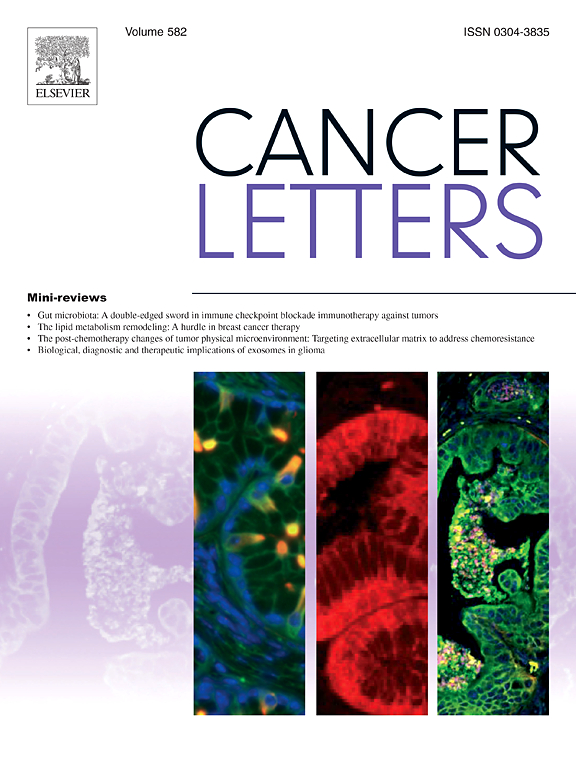Lectin-affinity glycosylation pattern analysis of plasma extracellular vesicles: An all-in-one clinical assessment for gastric cancer diagnosis and treatment
IF 9.1
1区 医学
Q1 ONCOLOGY
引用次数: 0
Abstract
Extracellular vesicles (EVs) exhibit extensive glycosylation modifications, which are promising biomarkers for gastric cancer (GC). However, EV glycomics and the potential application of EV glycosylation patterns in liquid biopsy remain largely unexplored. This study aims to elucidate the heterogeneity of EV glycosylation in the initiation and progression of GC and to identify specific EV glycosylation markers for clinical assessment. We developed a novel platform for analyzing EV glycosylation patterns via a lectin microarray for EV glycosyl-lectin affinity assessment and antibody-based EV subgroup annotation. The lectin-affinity glycosylation pattern (LAGP) of plasma EVs was profiled across 84 plasma samples, encompassing cases from different stages of GC, benign gastric diseases (BD), and non-disease control (NC). We uncovered heterogeneous LAGPs in different patient groups, identified group-specific LAGPs, and employed them in modeling with the assistance of machine learning algorithms. The linear discriminant analysis (LDA) distinguished advanced GC, early GC, BD, and NC samples with 100 % accuracy. A LAGP-based nomogram was established to predict survival outcomes within 200, 300, and 500 days, achieving area under the ROC curve (AUC) of 0.793, 0.914, and 0.988, respectively. We also tested LAGP for immunotherapeutic response prediction, obtaining AUC values of 0.866–1.000 with various supervised machine-learning algorithms. In conclusion, we represented heterogeneous LAGPs during the occurrence and progression of GC and developed an all-in-one clinical assessment tool for screening cancer patients, monitoring survival outcomes, and predicting immunotherapeutic responses.
血浆细胞外囊泡凝集素亲和糖基化模式分析:胃癌诊断和治疗的综合临床评估
细胞外囊泡(EVs)表现出广泛的糖基化修饰,是胃癌(GC)有希望的生物标志物。然而,EV糖组学和EV糖基化模式在液体活检中的潜在应用在很大程度上仍未被探索。本研究旨在阐明EV糖基化在胃癌发生和发展中的异质性,并确定特异性EV糖基化标记物用于临床评估。我们开发了一个新的平台,通过凝集素微阵列分析EV糖基化模式,用于EV糖基-凝集素亲和力评估和基于抗体的EV亚群注释。在84份血浆样本中分析了血浆ev的凝集素亲和糖基化模式(LAGP),包括不同阶段的胃癌、良性胃疾病(BD)和非疾病对照(NC)病例。我们发现了不同患者组中的异构lagp,确定了组特异性lagp,并在机器学习算法的帮助下将其用于建模。线性判别分析(LDA)以100%的准确率区分晚期GC,早期GC, BD和NC样品。建立基于lagp的nomogram预测200天、300天和500天的生存结局,ROC曲线下面积(AUC)分别为0.793、0.914和0.988。我们还测试了LAGP用于免疫治疗反应预测,通过各种监督机器学习算法获得了0.866-1.000的AUC值。总之,我们代表了胃癌发生和发展过程中的异质性LAGPs,并开发了一种用于筛查癌症患者、监测生存结果和预测免疫治疗反应的一体化临床评估工具。
本文章由计算机程序翻译,如有差异,请以英文原文为准。
求助全文
约1分钟内获得全文
求助全文
来源期刊

Cancer letters
医学-肿瘤学
CiteScore
17.70
自引率
2.10%
发文量
427
审稿时长
15 days
期刊介绍:
Cancer Letters is a reputable international journal that serves as a platform for significant and original contributions in cancer research. The journal welcomes both full-length articles and Mini Reviews in the wide-ranging field of basic and translational oncology. Furthermore, it frequently presents Special Issues that shed light on current and topical areas in cancer research.
Cancer Letters is highly interested in various fundamental aspects that can cater to a diverse readership. These areas include the molecular genetics and cell biology of cancer, radiation biology, molecular pathology, hormones and cancer, viral oncology, metastasis, and chemoprevention. The journal actively focuses on experimental therapeutics, particularly the advancement of targeted therapies for personalized cancer medicine, such as metronomic chemotherapy.
By publishing groundbreaking research and promoting advancements in cancer treatments, Cancer Letters aims to actively contribute to the fight against cancer and the improvement of patient outcomes.
 求助内容:
求助内容: 应助结果提醒方式:
应助结果提醒方式:


